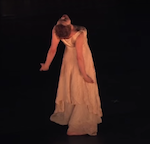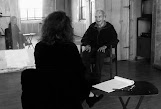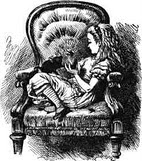The very first performances of Merce Cunningham's "Split Sides" were at the Brooklyn Academy of Music, where it returns this week for two final performances, each night occasioning a series of dice tosses to select among the many possible combinations of set, costumes, music, lights, and choreography. Here is a diary of those first four evenings, and what they revealed.
October 14, 16-18, 2003
Rolling the dice gives a moment of wonder, the imagination conjuring.
A split-second later, the dice at rest, the mind becomes active.
OF ALL of the multiple innovations in the work of Merce Cunningham, the use of chance is the most confusing. Such a clear thing, this toss of a die, or a handful of pennies, and yet chance is the part of the Cunningham dogma taken on faith, and dimly apprehended.
The independence of dance as an art form–the notion that dance does not need music, but may simply coexist with it—still may seem heresy to some, but as an idea it is well understood. The separation of dance from story is now old hat, or old enough, though still giving rise to the notion that Cunningham's dances are "abstract," when dance, because it is done by people, can never really be abstract.
BUT CHANCE! Chance makes people think of randomness, of disorder, of improvisation, of fate and fortune, of things made up as they are happening, or just before. Nothing, though, could be further from the Merceian truth, which is quite the opposite. His is not the unhinged Miltonic world of Paradise Lost, where "Chaos umpire sits," and "Chance governs all." Not in the slightest. In his world, Merce governs all, even when by a kind of non-doing, this latter being neither benign nor malign, but a kind of sovereign absenting of ego. Even when Cunningham does not make choices—as when, for instance, he leaves the decor to the art director, or some similar personage, who chooses the artists; and likewise hands off the music—he has chosen the chooser. The truth is that in his world, Cunningham is God, or, in terms of the Tao, the center of the wheel from which all spokes extend.
Every choice, or non-choice, is made by him.
The independence of dance as an art form–the notion that dance does not need music, but may simply coexist with it—still may seem heresy to some, but as an idea it is well understood. The separation of dance from story is now old hat, or old enough, though still giving rise to the notion that Cunningham's dances are "abstract," when dance, because it is done by people, can never really be abstract.
BUT CHANCE! Chance makes people think of randomness, of disorder, of improvisation, of fate and fortune, of things made up as they are happening, or just before. Nothing, though, could be further from the Merceian truth, which is quite the opposite. His is not the unhinged Miltonic world of Paradise Lost, where "Chaos umpire sits," and "Chance governs all." Not in the slightest. In his world, Merce governs all, even when by a kind of non-doing, this latter being neither benign nor malign, but a kind of sovereign absenting of ego. Even when Cunningham does not make choices—as when, for instance, he leaves the decor to the art director, or some similar personage, who chooses the artists; and likewise hands off the music—he has chosen the chooser. The truth is that in his world, Cunningham is God, or, in terms of the Tao, the center of the wheel from which all spokes extend.
Every choice, or non-choice, is made by him.
In the chance procedures Cunningham uses at some point in the making of each of his dances, all the available elements are his. This movement first, or that one? The moves are all his. What number of dancers? The number available is up to him. Chance is simply a marvelous surprise-generator. And Cunningham likes surprises. Thus he must have enjoyed his season this past week at the Brooklyn Academy of Music, where chance procedures went public.
THE WORLD PREMIERE OF SPLIT SIDES
Iacta alea est.
The die is cast.
(Julius Caesar, 1st Century B.C.)
The die is cast.
(Julius Caesar, 1st Century B.C.)
There are two scores, commisioned from the British Radiohead, playing live opening night, and the Icelandic Sigur Rós, who sweetly fall in love with the dancers and, as it turns out, will stay on in the pit for the whole run. Each band has composed a piece of twenty minutes and Cunningham has made two dances of twenty minutes (known as A and B ).
There are two backdrops, both by photographers. One is by the 18-year old Robert C. Heishman, who works in black and white ( often using cameras made from everyday objects, with film in one end and a pin hole at the other.) The other is by Catherine Yass, working in color (using a large-format camera, and layering and lighting techniques to produce composite images with manipulated and heightened coloration).
There are two sets of costumes by James Hall, one black and white unitards, the other silky-looking bell-bottomed jumpsuits, all sleeveless, with acid-trip coloration. Each set of clothes is similarly imprinted with a network of black crisscrosses and branches suggesting twigs, or spider webs.
There are two light plots. So that we can see the whole thing, James. F. Ingalls has been called upon to devise interchangeable light plots, which, as a convenience, are given numeric names. One is from the 200 Series; the other from the 300 Series.
ON THE DAY OF PERFORMANCE, Cunningham handed someone a die to cast, to determine the order of the two dance parts. The other elements were selected on stage before each performance of "Split Sides."( After a time, the dancers grew accustomed to the work, and the dance element also was selected right before the performance, with the dancers dashing off stage to jump into the right costumes, keeping which part of the dance was first in their heads as they dashed.)
There are two light plots. So that we can see the whole thing, James. F. Ingalls has been called upon to devise interchangeable light plots, which, as a convenience, are given numeric names. One is from the 200 Series; the other from the 300 Series.
ON THE DAY OF PERFORMANCE, Cunningham handed someone a die to cast, to determine the order of the two dance parts. The other elements were selected on stage before each performance of "Split Sides."( After a time, the dancers grew accustomed to the work, and the dance element also was selected right before the performance, with the dancers dashing off stage to jump into the right costumes, keeping which part of the dance was first in their heads as they dashed.)
FIRST NIGHT
ON OPENING NIGHT, the curtain went up on Michael Bloomberg, the Mayor of New York City, who introduced Merce Cunningham and two of his former artistic directors, Robert Rauschenberg and Jasper Johns, there to roll the die. Three titans of twentieth century modernism , gamely chancing it in the twenty-first.
Cunningham walked with a cane now, and not easily, with the Merlinishness he has long exhibited is in full flower. He really did seem to travel backwards through time, meeting up with the young and showing them the way to the future.
Rauschenberg had suffered a stroke, but his merriness seemed intact. He was, as ever, a really loveable public personage.
Johns, in contrast, exhibited a truly magisterial aloofness, not the usual aspect of someone who is about to roll snake eyes (or not).
These personal characteristics were not so very different from the characters of their art: magical, warm, cool. To see them together was, well, something. Joining them on stage were the company's patroness saint, Sage Cowles; Cunningham's beautifun longtime dance partner Carolyn Brown; the bands; and the designers; and the dancers, who popped up now and then as they jumped to maintain a warmed-up state.
Cunningham walked with a cane now, and not easily, with the Merlinishness he has long exhibited is in full flower. He really did seem to travel backwards through time, meeting up with the young and showing them the way to the future.
Rauschenberg had suffered a stroke, but his merriness seemed intact. He was, as ever, a really loveable public personage.
Johns, in contrast, exhibited a truly magisterial aloofness, not the usual aspect of someone who is about to roll snake eyes (or not).
These personal characteristics were not so very different from the characters of their art: magical, warm, cool. To see them together was, well, something. Joining them on stage were the company's patroness saint, Sage Cowles; Cunningham's beautifun longtime dance partner Carolyn Brown; the bands; and the designers; and the dancers, who popped up now and then as they jumped to maintain a warmed-up state.
After Cunningham explained the chance process, to no small confusion and amusement on the part of the audience, a die was produced for an on-the-spot determination of which of each two-part production component would go first. (David Vaughan, the Cunningham archivist and chronicler, serves as the master of ceremonies during these procedures.) So, the titans of modernism tossed the die.
This yielded the following two-part version of the work:
This yielded the following two-part version of the work:
Dance: A/B
Music: Radiohead/Sigur Rós
Sets: Heishman/Yass
Costumes: black & white/color
Light: 300/200
Music: Radiohead/Sigur Rós
Sets: Heishman/Yass
Costumes: black & white/color
Light: 300/200
"A gimmick," a man behind me would mutter later in the week, on the last night. (And it does take a lot of explaining, before one can even begin to get at the dancing itself.) But as it turned out, not a gimmick, but a revelation.
For while the elements stayed the same from performance to performance , they would vary in their combination, though very slightly, as chance had it.
The affect of the choreography, and the effect, would change from performance to performance, depending on the order of its arrival, what it wore, and where it was. (Just as you yourself appear different in a bathing suit at the beach or a winter coat at a funeral, though you may be standing the same way, and thinking the same thing.)
One could make an aesthetic judgement about the various results; one might have a preference. From evening to evening, one went home floating on air, or shuddering. The audience response was vivid each night—the houses were sold out, right up to the rafters—but the group preference was clearly for color, for pleasure, and for a happy ending.
So it was on the first night, which went from dark to light.
The affect of the choreography, and the effect, would change from performance to performance, depending on the order of its arrival, what it wore, and where it was. (Just as you yourself appear different in a bathing suit at the beach or a winter coat at a funeral, though you may be standing the same way, and thinking the same thing.)
One could make an aesthetic judgement about the various results; one might have a preference. From evening to evening, one went home floating on air, or shuddering. The audience response was vivid each night—the houses were sold out, right up to the rafters—but the group preference was clearly for color, for pleasure, and for a happy ending.
So it was on the first night, which went from dark to light.
Black and white costumed dancers in front of a black and white backdrop depicting what was perhaps a ruined roller coaster, glimpsed through fog.
The lighting throughout enhancing directionality—if the dancers looked up, light took their upturned faces. From the sides, light enhanced curves, sharpened angles. Unobtrusive shifts in lighting levels, giving a sense of time passing, and of narrative—light suggesting, as it does, time of day, and time passing, or place changing, without overtly imposing meaning.
Radiohead offered a sonorous and serious score, varied in texture, and with no overwhelming beat. It was not so very different in kind from other electronic music the company has commissioned in the past, and one felt the rockers were making a bid to follow in the serious footsteps of the electronic composers who have preceded them on the company roster. At any rate, they gave themselves over to the cause at hand, and served the Cunningham well.
If the whole of this first half of Split Sides was wintry, hermetic, arctic, with the observing mind bouncing off the whole thing to careen around feeling very much alone, and the feeling heart pierced to the core, the second half was, to borrow an expression from Cunningham, an "all candy dinner."
The effect was of starting off in Kansas, and ending up in Oz.
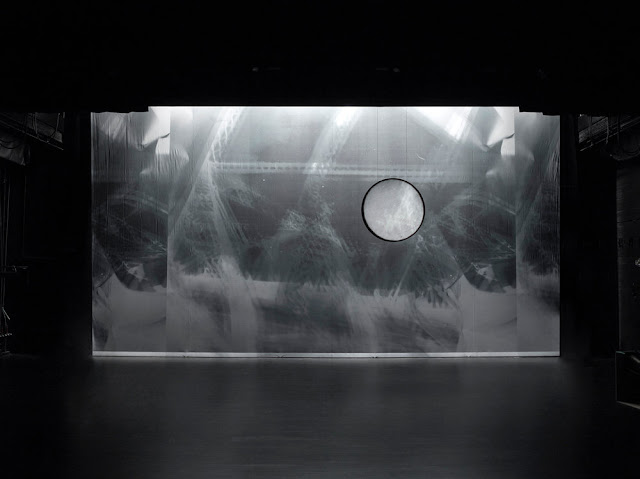 |
| Robert Chase Heishman |
Radiohead offered a sonorous and serious score, varied in texture, and with no overwhelming beat. It was not so very different in kind from other electronic music the company has commissioned in the past, and one felt the rockers were making a bid to follow in the serious footsteps of the electronic composers who have preceded them on the company roster. At any rate, they gave themselves over to the cause at hand, and served the Cunningham well.
If the whole of this first half of Split Sides was wintry, hermetic, arctic, with the observing mind bouncing off the whole thing to careen around feeling very much alone, and the feeling heart pierced to the core, the second half was, to borrow an expression from Cunningham, an "all candy dinner."
The effect was of starting off in Kansas, and ending up in Oz.
 The costumes were happy and bright and sugary, the photographic backdrop smeared buildings into towering pastel after dinner mints, and Sigur Rós employed a xylophone; a battery of timpani constructed of toe shoes; the recorded sounds of a baby cooing; and some wind-up devices they happily used to tick-tock along with what they could see from the pit.
The costumes were happy and bright and sugary, the photographic backdrop smeared buildings into towering pastel after dinner mints, and Sigur Rós employed a xylophone; a battery of timpani constructed of toe shoes; the recorded sounds of a baby cooing; and some wind-up devices they happily used to tick-tock along with what they could see from the pit. Thus as Derry Swan spun thrice around her partner Cedric Andrieux, Venus cavorting with Mars, the musicians made merry matching sounds. (For those who were appalled by this, given the dogma of separation of the various elements of the production, I would only point out that the late David Tudor, Cunningham's music director after Cage's death, and a long time pit musician and composer for the company, by his own admission did the same thing, though not in such a rudimentary way. He admitted this to me backstage at the Paris Opera, after the first performance of "Enter," when from my vantage point he could be seen ramping up the sound when the stage grew dark and dull and overshadowed by the set, as if in counter-balance. In other words, if there are rules, they had already been broken.)
This part of the work also contains two passages of enormous warmth—a solo first danced by the beautiful Jonah Bokaer, and a quadruple duet—that is, the same duet multiplied by four, that reads like a sermon on love, with each couple doing the same thing, but in its own touching and individual way. The choregraphy here incorporate a ravishing figure in which the woman climbs onto her partners' back as he lunges to one side, is carried over onto his front as he shifts to a lunge on other side, and knifes her legs over to end up behind him again. This is a beautiful and rapt a phrase as Cunningham has made.
Despite these lush interludes, and also a comedic trio reminiscent of the Cunningham videodance "Delicomedia," much of "Split Sides" is fiendishly difficult, and notably spare.
It can readily be characterized as Late Cunningham, with the choreographer frequently working in multiple images of the same figure—for instance, eight dancers each doing the same thing, but each with a different front, so we see the step from different sides at the same time. 360 degrees, all from your seat.
CUNNINGHAM always stands at a kind of choreographic South Pole where every direction is North; or alternatively a North Pole, where every direction is South. For him, every direction is front. Here he fractures the figure into multiples, in angular, sparse poses that refract each other, so that the stage is a prism. This part of his work is unforgiving, and from a distance, chilly. Up close, as from the second row, the personalities of the dancers enliven it. Where you sit makes the dance different as much as any chance changes rung before the curtain—but that is always true at a dance performance. You can sit back, and see the night sky, or sit close, and see the human condition.
It can readily be characterized as Late Cunningham, with the choreographer frequently working in multiple images of the same figure—for instance, eight dancers each doing the same thing, but each with a different front, so we see the step from different sides at the same time. 360 degrees, all from your seat.
CUNNINGHAM always stands at a kind of choreographic South Pole where every direction is North; or alternatively a North Pole, where every direction is South. For him, every direction is front. Here he fractures the figure into multiples, in angular, sparse poses that refract each other, so that the stage is a prism. This part of his work is unforgiving, and from a distance, chilly. Up close, as from the second row, the personalities of the dancers enliven it. Where you sit makes the dance different as much as any chance changes rung before the curtain—but that is always true at a dance performance. You can sit back, and see the night sky, or sit close, and see the human condition.
SECOND NIGHT
Times go by turns, and chances change by course,
From foul to fair, from better hap to worse.
Robert Southwell (Times go by Turns, 1595)
The throws of the die yield even, even, odd, odd. Only one element changes, the costumes. Thus:
Times go by turns, and chances change by course,
From foul to fair, from better hap to worse.
Robert Southwell (Times go by Turns, 1595)
The throws of the die yield even, even, odd, odd. Only one element changes, the costumes. Thus:
Dance: A/B
Music: Radiohead/Sigur Rós
Sets: Heishman/Yass
Costumes: color/black&white
Light: 300/200
Music: Radiohead/Sigur Rós
Sets: Heishman/Yass
Costumes: color/black&white
Light: 300/200
Rather surprisingly, the flipping of costumes makes a new dance—or perhaps the same dance with a different mood. In fact, Split Sides looks very moody indeed this way, resembling some sort of cruel psych experiment.
To wit: in an arctic landscape, some Tahitians are set down. And vice-versa in the second part. Instead of harmony, disjunction; and the drama of contrast, but only visual. (These would not be the inherent contrasts of Cunningham choreography, where fast—and these days faster, faster, faster!—is set against slow, light against heavy, aerial against grounded, and so forth.)
In sum: the dance was easier on the eye last night, and it has given up its unity of impression. This isn't to say there is a better version or a worse. But there is a pleasant and a much less pleasant. The disharmony tonight only points up the exigencies of this particular format, with the parts transposible.
To wit: in an arctic landscape, some Tahitians are set down. And vice-versa in the second part. Instead of harmony, disjunction; and the drama of contrast, but only visual. (These would not be the inherent contrasts of Cunningham choreography, where fast—and these days faster, faster, faster!—is set against slow, light against heavy, aerial against grounded, and so forth.)
In sum: the dance was easier on the eye last night, and it has given up its unity of impression. This isn't to say there is a better version or a worse. But there is a pleasant and a much less pleasant. The disharmony tonight only points up the exigencies of this particular format, with the parts transposible.
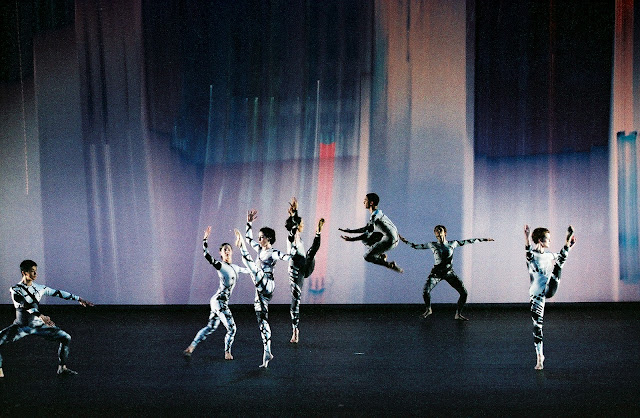 |
| The Merce Cunningham Dance Company |
By neccessity, "Split Sides" feels on first enounter like a Cunningham "Event," one of those signature amalgams of parts of various dances, rather than one of the great repertory works possessed of an ineluctible inevitablity. Because the halves can run in either order, they have to have beginnings and ends that won't put a dancer in two places at once, or in one place wearing one costume one second, and another the next. Thus the troupe is divided in half at signal junctures.
But company and continuity are not the only things split. The body itself is split every which way—one half against another, side to side, top to bottom—and dancers themselves are split, even when dancing together. As evidence there exists the most difficult, cool, clinical duet ever devised by Cunningham, first danced by two virtuosi of the impossible, the firebrand Holly Farmer and the soulful Daniel Squire. In this encounter, neither seemed to have anything to do with the other; they intersect with hostile inadvertence. In the end, in anything but abandonment—she gives the feeling she could just reverse course with no need of a partner—Farmer fell back into Squire's arms in just the way that Cathy Kerr fell back into Alan Good's arms in the Cunningham masterpiece "Points in Space." So similar, so different.
But company and continuity are not the only things split. The body itself is split every which way—one half against another, side to side, top to bottom—and dancers themselves are split, even when dancing together. As evidence there exists the most difficult, cool, clinical duet ever devised by Cunningham, first danced by two virtuosi of the impossible, the firebrand Holly Farmer and the soulful Daniel Squire. In this encounter, neither seemed to have anything to do with the other; they intersect with hostile inadvertence. In the end, in anything but abandonment—she gives the feeling she could just reverse course with no need of a partner—Farmer fell back into Squire's arms in just the way that Cathy Kerr fell back into Alan Good's arms in the Cunningham masterpiece "Points in Space." So similar, so different.
THIRD NIGHT
All nature is but art, unknown to thee;
All chance, direction which thou canst not see....
(Alexander Pope, An Essay on Man, 1733)
Everything turns up even. Thus:
All chance, direction which thou canst not see....
(Alexander Pope, An Essay on Man, 1733)
Everything turns up even. Thus:
Dance: A/B
Music: Radiohead/Sigur Rós
Sets: Heishman/Yass
Costumes: black&white/color
Light: 200/300
Music: Radiohead/Sigur Rós
Sets: Heishman/Yass
Costumes: black&white/color
Light: 200/300
This is the same as the first night but with the lights switched, by far the most subtle change one can ring here. Light, which enables us to see, is hard itself to hold in the mind.
FOURTH NIGHT
Un coup de dés jamais n'abolira le hasard.
A throw of the dice will never eliminate chance.
(Stéphane Mallarmé, 1897)
A throw of the dice will never eliminate chance.
(Stéphane Mallarmé, 1897)
BY NOW there is consternation in the front of the house, and a certain disbelief backstage.
Night after night, and still the same order of music, dance, set!
(If anyone thought the results were rigged, this certainly proved contrary—one somehow expected, and even hoped for a dog's dinner night to night, with everything all mixed up.) The pre-show cast inverted the dance order, so hopes were high at the public tosses—but the die came up odd all the way.
Night after night, and still the same order of music, dance, set!
(If anyone thought the results were rigged, this certainly proved contrary—one somehow expected, and even hoped for a dog's dinner night to night, with everything all mixed up.) The pre-show cast inverted the dance order, so hopes were high at the public tosses—but the die came up odd all the way.
Odd! Odd! Odd! Odd! The two halves of the production were identical to the night before, but flipped. Thus:
Dance: B/A
Music: Sigur Rós/Radiohead
Sets: Yass/Heishman
Costumes: color/black&white
Light:300/200
Music: Sigur Rós/Radiohead
Sets: Yass/Heishman
Costumes: color/black&white
Light:300/200
Same old, same old, one should think.
But no. The consequent change to the work is astonishing.
Brought forth by a few rolls of a single die, tragedy comes calling. The first part, all warmth and sweetness, with young Jonah in his solo and the four couples in their love song, yields to the harsh wintry second part, with the dancers looking like extremely intelligent aliens who have just this moment come to inhabit human bodies, trying them out for the first time without knowing any of the human rules of moving.
The eye glances off what it does not recognize—the glinting surface of the unfamiliar, as glances, too, the mind. Bleak, bleak, bleak—the summer of the first half giving way to winter, sunlit youth yielding to starlit age, remote and chill.
At the curtain calls that night, radiant Jeannie Steele—whose love for the dancing so suited her to be the choreographer's guardian angel—stepped off to get Cunningham. He entered on her arm and joined his troupe, taking his place at the far left of the stage. The company stepped back to allow him a solo bow, then turned as one to applaud him, so courteous, so gallant, so persevering, standing there in a brilliant orange shirt.
Shortly thereafter, the curtain came down on the Merce Cunningham Dance Company's New York season. The company flew off to other theaters, other performances, Cunningham still then traveling along to run the show .
WHATEVER CHANCE procedures he used in making the repertory were been made during during the choreographic process, the results striking sparks to his own creativity.
He did not take any chances on his dancers, whom he selected and cast.
And for all the freedom he allowed his composers and his visual artists, their work was made before the curtain rises (though the music often contained variables).
But there was indeed a rogue element at play at the time of the performance—an element that is random, uncontrollable, unknowable ahead of the event.
Dicey in every way.
That element would be us, coming into the theater with our minds cluttered and our sensibilities settled, carting around the baggage of the day.
NIGHT AFTER NIGHT, year after year, in city after city, Merce Cunningham took a chance on us.
But no. The consequent change to the work is astonishing.
Brought forth by a few rolls of a single die, tragedy comes calling. The first part, all warmth and sweetness, with young Jonah in his solo and the four couples in their love song, yields to the harsh wintry second part, with the dancers looking like extremely intelligent aliens who have just this moment come to inhabit human bodies, trying them out for the first time without knowing any of the human rules of moving.
The eye glances off what it does not recognize—the glinting surface of the unfamiliar, as glances, too, the mind. Bleak, bleak, bleak—the summer of the first half giving way to winter, sunlit youth yielding to starlit age, remote and chill.
At the curtain calls that night, radiant Jeannie Steele—whose love for the dancing so suited her to be the choreographer's guardian angel—stepped off to get Cunningham. He entered on her arm and joined his troupe, taking his place at the far left of the stage. The company stepped back to allow him a solo bow, then turned as one to applaud him, so courteous, so gallant, so persevering, standing there in a brilliant orange shirt.
Shortly thereafter, the curtain came down on the Merce Cunningham Dance Company's New York season. The company flew off to other theaters, other performances, Cunningham still then traveling along to run the show .
 |
| Merce Cunningham (with Robert Swinston) at the Round House in London in 2006 courtesy of Hugo Glendinning |
WHATEVER CHANCE procedures he used in making the repertory were been made during during the choreographic process, the results striking sparks to his own creativity.
He did not take any chances on his dancers, whom he selected and cast.
And for all the freedom he allowed his composers and his visual artists, their work was made before the curtain rises (though the music often contained variables).
But there was indeed a rogue element at play at the time of the performance—an element that is random, uncontrollable, unknowable ahead of the event.
Dicey in every way.
That element would be us, coming into the theater with our minds cluttered and our sensibilities settled, carting around the baggage of the day.
NIGHT AFTER NIGHT, year after year, in city after city, Merce Cunningham took a chance on us.
portrait of Merce Cunningham ©Hugo Glendinning
All other photos © Tony Dougherty
Portions of this essay were originally published by Alexandra Tomalonis in danceviewtimes (October 20, 2003)
Copyright © Nancy Dalva 2011
Copyright © Nancy Dalva 2011





